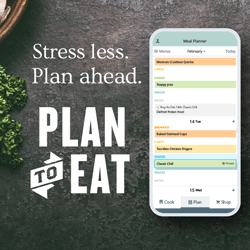As a dietitian, I am of the opinion that establishing a meal planning habit is one of the best things we can do for our health. That’s because it is so much easier (and less stressful!) to eat healthy when we’ve planned ahead. Whether you are an avid meal planner or are brand new to meal planning, this post is full of tips to help you be as successful as possible.
Schedule a time for meal planning
This sounds obvious, but it’s actually really important. If you don’t designate a time when you’re going to meal plan, then chances are, something will come up and it won’t get done. Decide, in advance, when you’re going to meal plan, and pencil it into your calendar.
For me, the best time to meal plan is Sunday evening. I get my recipes picked out and make my grocery list. This means I am ready to head to the store or make an online order by Monday morning. Then I can go get a week’s worth of groceries all at once. I wait to buy my seasonal produce until Tuesday morning, at the farmer’s market, since I know I will get the best ingredients and price there (plus support local farmers).
Think about your current life circumstances, and decide which time would work best for you. Bonus points if you’re able to pick the same time each week to do it. It will help you to cement meal planning as a habit.
Give yourself the space you need to meal plan
Just like setting aside the time to meal plan, you also need to set aside the physical space to do it. It’s going to be difficult to put pencil to paper if everything you need is scattered about, or you can’t find a clean space at the kitchen table to sit down at. By a similar token, make sure that you know where your recipes are, be they online or in a cookbook, so you can easily access them when it is time to start planning.
In my house, all the cookbooks are on one section of the bookshelf (which is the room next to the kitchen, for ease of access when I’m cooking). I also use the platform Plan to Eat to house my online recipes.

If you’re a paper-and-pencil meal planner, I recommend setting up a little nook with some meal planning sheets, some of your favorite pens or pencils, or even a bullet journal if that’s your thing. Make it a fun space to be in, and you are more likely to use it.
Likewise, if you meal plan on your computer, then make sure you find a place to work that is conducive to meal planning. In my house, this means a quiet place where my children won’t interrupt me and I can get things done more efficiently. Because my supplies are easily accessible, when it is time to meal plan, I can easily peruse my recipes and figure out what I want to make.
“Recycle, reduce, and reuse” to simplify meal planning
We’ve all heard that we should recycle, reduce, and reuse when it comes to helping the environment, but I believe that we can apply this adage to meal planning too. Here’s what that looks like:
- Recycle your old meal plans. Just because the week is done, it doesn’t mean those plans are no longer good. You spent time and effort making them. Tweak what you’ve already created, and you will save yourself time in the long run (both time spent meal planning and time spent cooking/preparing food, since you will be familiar with the recipes already).
- Reduce the number of changes you’re making to your current menu. What I mean by this is don’t change too many things at once. If you are currently eating out three days per week, don’t make a plan to cook gourmet meals seven days per week. You don’t need to create a brand new menu with brand new foods you’ve never made before each week. The good old standbys do have a place in your meal planning.
- Reuse foods, in the form of leftovers. I’ve even heard this referred to as “planned-overs.” There is nothing wrong with making a little extra so you don’t have to cook two days in a row. This is especially true if you know you have a busy day coming up.
Match your meal plan to your cooking skills and lifestyle
Cooking skills
Not everyone is a chef, and not everyone likes to cook. This is totally fine! You don’t have to love cooking to be successful at meal planning. Before you decide what you’re going to eat for the week, first take a moment to think about your cooking ability. Then take that information and use it to make meal plans based on what you can and actually want to do in the kitchen.
How does this look in practice? If you don’t cook, then use pre-prepped ingredients from the store and combine them into balanced meals (think: skinless rotisserie chicken with a side of frozen veggies, a roll from the bakery, and pre-cut apples slices). Most people, even non-cooks, are perfectly able to do the basics, like boil water, turn on the oven, or use the microwave.
If you’re sort of into cooking but aren’t stellar at it, then make things that match your skillset. If you know there’s one dish that tastes great every time you make it, then put that into your meal planning rotation. Pre-read recipes to make sure you understand and are able to follow the steps presented there. Try to pick recipes that don’t have complicated ingredients, or that you need to go to three different stores to buy.
If you want to learn to cook, start simple, with 4-5 ingredient recipes. Don’t make something crazy complicated from scratch. Boiling water to cook spaghetti and making a homemade sauce by heating up a can of crushed tomatoes with some garlic and Italian seasoning is a perfectly good starting place.
Lifestyle
As for matching meal planning to your lifestyle, if you work long hours, or if you are carting kids to and fro all afternoon, don’t plan dinners that take a long time to make or produce a lot of dishes to clean. Likewise, it’s a good idea to look at your calendar when you are meal planning to see if there are any events or appointments you’re going to need to work around.
An example of this in practice: on days when my son had occupational therapy 30 minutes away at dinnertime, I just picked up a pizza on the way home. But when I was meal planning for that day, I would make sure to put bagged salad on the shopping list to have with the pizza.
So, to summarize this section:
Keep things simple and doable, and you are more likely to follow through on them.
Troll the web for meal planning ideas and inspiration
We are living in the golden age of recipes, in my opinion, and a lot of that is due to the Internet. There are so many food bloggers out there, from all diet styles (vegan, paleo, gluten-free, etc.) that you are bound to find something that fits your budget, food preferences, and lifestyle. There are also cooking magazines, like Eating Well, that post their recipes online. Even the Food Network puts many of their recipes on the Internet.
Whether you’re searching for a particular recipe (e.g. “quinoa salad”) or you’ve got no ideas and need help getting started (e.g. “easy weeknight dinner”), you can do a Google search to easily find whatever it is that you need.
If you’re completely new to meal planning and have no idea where to begin, there are bloggers out there who will offer you starting meal plans, for free (usually if you join their email list). This can be a great source of inspiration, since you can see a whole week or month’s worth of meals laid out and then pick the ones you and your family would like.
Brainstorm menu ideas if you’re in a rut
On those days when I’m completely over meal planning, one thing that always helps is to brainstorm meal ideas. This can be done in a variety of ways:
- Pull cookbooks off the shelf and flip through the pages. When you see something you like, write down the recipe and page number, or bookmark it with a sticky note.
- Look through old meal plans to see if there’s anything you haven’t made recently that you know your family likes.
- Look through food blogs you have bookmarked on your computer. (For this one to work, you need to remember to bookmark a site when you find a recipe you like there.)
- Make a list, off the top of your head, of either things to eat or of broad food categories. For instance, you might write down “lentil bolognese,” or “Italian food,” or “Instant Pot meals,” or “vegan meals”, etc.
Ideally, any of the above will help to get ideas flowing, which will then increase your motivation and help you finish your meal plan. (A rut isn’t always a bad thing, since it forces you to get creative.)
Start where you are and make changes gradually
I do not believe in the all-or-nothing approach to meal planning (as in, I create a brand new perfect meal plan and follow it 100%, or I fail). I do believe in starting where you already are, with what you are currently eating, and then making tweaks along the way to move you in the direction of better health.
If you’ve ever tried dieting before, then you know that switching up all of your foods at once and suddenly forbidding many of your favorite things is not a recipe for a success. A better way is to move more organically towards better eating by focusing on one small change a time.
Don’t try to meal plan too much at once
When you’re new to meal planning, I recommend starting with planning dinners only. That’s because, in America at least, dinner tends to be the biggest meal of the day. Dinner is also a time when a lot of us really need to have already planned ahead (e.g. after a long day of work, with hungry kiddos who keep asking “what’s for dinner?”) If you can plan and execute a solid dinner menu, then you are well on your way to a successful meal planning habit.
I also recommend planning no more than a week at a time. As you get the hang of things, you can certainly plan more. Some people even do a month at a time. But if you’re new to meal planning, you’re going to learn things about yourself and your family, and you’re going to want to tweak things as you go along. Don’t create extra work for yourself by creating a month-long meal plan and then having to scrap it when you realize it’s not practical for your current situation.
I realize that it is cliche, but as they say, “a journey of a thousand miles begins with a single step.” Don’t overwhelm yourself. Do one thing, do it well, make it a habit, and then move on to the next step. You can meal plan like a pro, I promise. It just takes a little time.
What’s your favorite way to meal plan?
Share it in the comments below.







Great article!! It tells a very simple and easy way to ease into meal planning. I love to plan meals myself , but this will help me to do a better job of it.